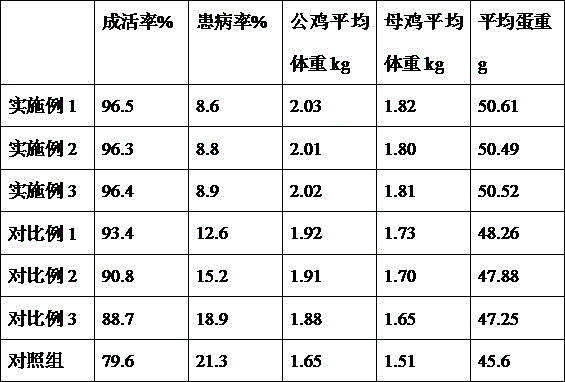Ecological native chicken breeding method
A native chicken and ecological technology, applied in the field of breeding, can solve the problems of poor immunity and disease resistance of native chickens, economic losses of farmers, and low survival rate, etc., and achieve the improvement of the average weight of hens, improve immunity, and survival rate high effect
- Summary
- Abstract
- Description
- Claims
- Application Information
AI Technical Summary
Problems solved by technology
Method used
Image
Examples
Embodiment 1
[0017] A method for raising ecological native chickens, comprising the following steps
[0018] (1) Select breeding eggs and incubate them for three weeks in an incubator with a temperature of 36.5°C and a relative humidity of 50% to obtain chicks, and raise the hatched chicks in a chick room with a temperature of 30°C for 7 days, then place the chicks at a temperature of 30°C. Breed in a chick room at 28°C for 2 days, and then lower the temperature by 2°C every day for 5 days to obtain dewarmed chicklings, and feed the extract of Clovergrass once a day in the chick room;
[0019] (2) When the chicken age reaches 10 weeks, use the concentrated feed and the green feed to feed together, feed the concentrated feed twice a day, and feed the green feed once, and increase the light for 1 hour every day for five days;
[0020] (3) 80-120 days is the breeding period. The roosters and hens are divided into groups. The indoor temperature of the chicken house is kept at 18°C for feedin...
Embodiment 2
[0022] A method for raising ecological native chickens, comprising the following steps
[0023] (1) Select breeding eggs and incubate them for three weeks in an incubator with a temperature of 37.8°C and a relative humidity of 54% to obtain chicks. The hatched chicks are raised in a chick room with a temperature of 32°C for 8 days, and then the chicks are kept at temperature Breed in a chick room at 30°C for 2 days, then lower the temperature by 2°C every day for 5 days to obtain dewarmed chicklings, and feed the extract of Clovergrass once a day in the chick room;
[0024] (2) When the chicken age reaches 10 weeks, use the concentrated feed and the green feed to feed together, feed the concentrated feed twice a day, and feed the green feed once, and increase the light for 1 hour every day for five days;
[0025] (3) 80-120 days is the breeding period. The roosters and hens are divided into groups. The indoor temperature of the chicken house is kept at 20°C for feeding, the re...
Embodiment 3
[0027] A method for raising ecological native chickens, comprising the following steps
[0028] (1) Select breeding eggs to hatch for three weeks in an incubator with a temperature of 37°C and a relative humidity of 52% to obtain chicks. The hatched chicks are raised in a chick room with a temperature of 31°C for 8 days, and then the chicks are kept at temperature Breed in a chick room at 29°C for 2 days, then lower the temperature by 2°C every day for 5 days to obtain dewarmed chicklings, and feed the extract of Clovergrass once a day in the chick room;
[0029] (2) When the chicken age reaches 10 weeks, use the concentrated feed and the green feed to feed together, feed the concentrated feed twice a day, and feed the green feed once, and increase the light for 1 hour every day for five days;
[0030] (3) 80-120 days is the breeding period. The roosters and hens are divided into groups. The indoor temperature of the chicken house is kept at 19°C for feeding, the relative humi...
PUM
 Login to View More
Login to View More Abstract
Description
Claims
Application Information
 Login to View More
Login to View More - R&D
- Intellectual Property
- Life Sciences
- Materials
- Tech Scout
- Unparalleled Data Quality
- Higher Quality Content
- 60% Fewer Hallucinations
Browse by: Latest US Patents, China's latest patents, Technical Efficacy Thesaurus, Application Domain, Technology Topic, Popular Technical Reports.
© 2025 PatSnap. All rights reserved.Legal|Privacy policy|Modern Slavery Act Transparency Statement|Sitemap|About US| Contact US: help@patsnap.com

